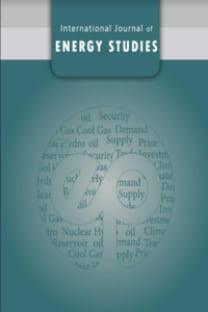Bahadir ACAR, Abdullah DAĞDEVİREN, Ahmed JANAANİ, Khandan ROSHANAEI, Edip TAŞKESEN, Göknur KAYATAŞ ONGUN, Mehmet ÖZKAYMAK
Freeze- Drying of Carrot Slices in Diverse Thicknesses
In this paper we dried carrots by the method of freeze-drying. The carrots had cut in slices; then divided in halves. The mass looses of samples sized. The mass losses measured and recorded during the process. The sections were in 5 mm and 7 mm. Slices were dried with SCANVAC COOLSAFE. Weights of the carrot slices differed also in each unit with the same weight and shape varied. Our team did the drying procedures every two hours, also the experiment applied by different temperatures. While evaluating the amount of carrot slices as samples for freeze-dried observed that, dried samples amount were 5 times less than the amount of carrots before drying. The procedure applied with 10 different mathematical models using the MATLAB program. The error analysis of the models at the result v made by using the estimated standard error (RMSE), chi-square (X2) and regression coefficients (R2). According to the results, it determined that the results of the Page model were closer as the experimental results by compared to other models. The statistical error values of samples for R2, RMSE respectively were 0.018565707 for 5 mm and 0.019532936 for 7 mm.
Keywords:
Freeze drying, vegetable drying, kinetic drying mode,
___
- M. Iorizzo, J. Curaba, M. Pottorff, M. G. Ferruzzi, P. Simon, and P. F. Cavagnaro, “Carrot anthocyanins genetics and genomics: status and perspectives to improve its application for the food colorant industry.”, Genes (Basel)., vol. 11, no. 8, Aug. 2020, doi: 10.3390/genes11080906.
- M. Iorizzo et al., “Genetic structure and domestication of carrot (Daucus carota subsp. sativus)(Apiaceae)”, Am. J. Bot., vol. 100, no. 5, pp. 930–938, 2013.
- A. T. Zatla et al., “Chemical variability of essential oil of Daucus carota subsp. sativus from Algeria”, J. Herbs. Spices Med. Plants, vol. 23, no. 3, pp. 216–230, 2017.
- J. Paull, “Organic food and agriculture in food and society”, Elsevier, 2020, pp. 179–199.
- H. Sadikoglu, A. I. Liapis, and O. K. Crosser, “Optimal control of the primary and secondary drying stages of bulk solution freeze drying in trays”, Dry. Technol., vol. 16, no. 3–5, pp. 399–431, 1998.
- B. Acar, H. Sadikoglu, and I. Doymaz, “Freeze-drying kinetics and diffusion modeling of Saffron (Crocus sativus L.)”, J. Food Process. Preserv., vol. 39, no. 2, pp. 142–149, 2015.
- H. O. Menges and C. Ertekin, “Mathematical modeling of thin layer drying of Golden apples”, J. Food Eng., vol. 77, no. 1, pp. 119–125, 2006, [Online]. Available: https://doi.org/10.1016/j.jfoodeng.2005.06.049.
- A. Vega-Gálvez, M. Miranda, C. Bilbao-Sáinz, E. Uribe, and R. Lemus-Mondaca, “Empirical modeling of drying process for apple (Cv. Granny Smith) slices at different air temperatures” J. Food Process. Preserv., vol. 32, no. 6, pp. 972–986, 2008.
- K. Rayaguru, W. Routray, and S. N. Mohanty, “Mathematical modeling and quality parameters of air-dried betel leaf (piper betle L.)”, J. Food Process. Preserv., vol. 35, no. 4, pp. 394–401, 2011.
- Yayın Aralığı: Yılda 4 Sayı
- Başlangıç: 2016
- Yayıncı: Türkiye Enerji Stratejileri ve Politikaları Araştırma Merkezi (TESPAM)
Sayıdaki Diğer Makaleler
Bahadir ACAR, Abdullah DAĞDEVİREN, Ahmed JANAANİ, Khandan ROSHANAEI, Edip TAŞKESEN, Göknur KAYATAŞ ONGUN, Mehmet ÖZKAYMAK
The Model of “Free Investment & Centralised Management” in Renewable Energy Production Projects
Selman DEMİRKESEN, Halil VARİYENLİ
